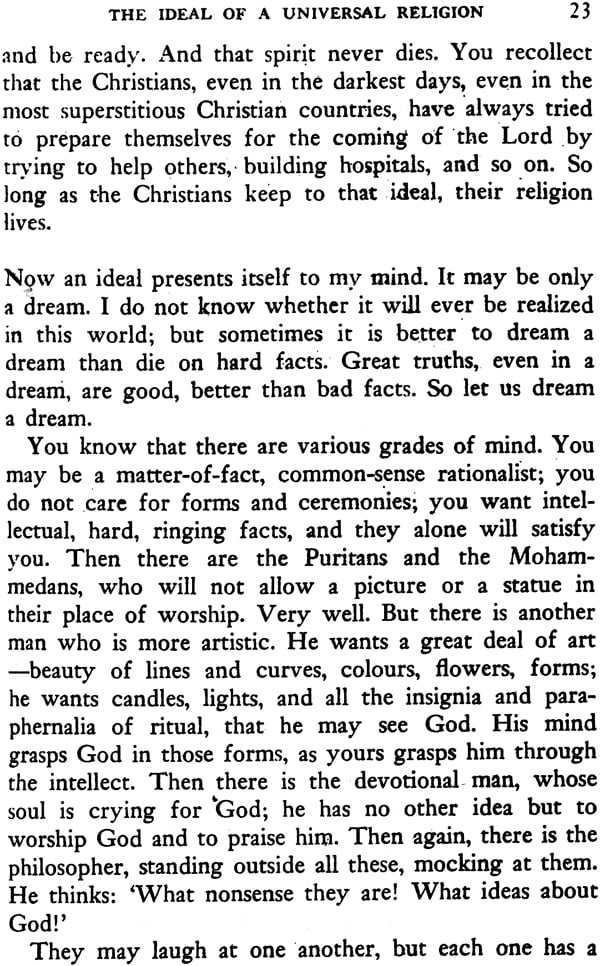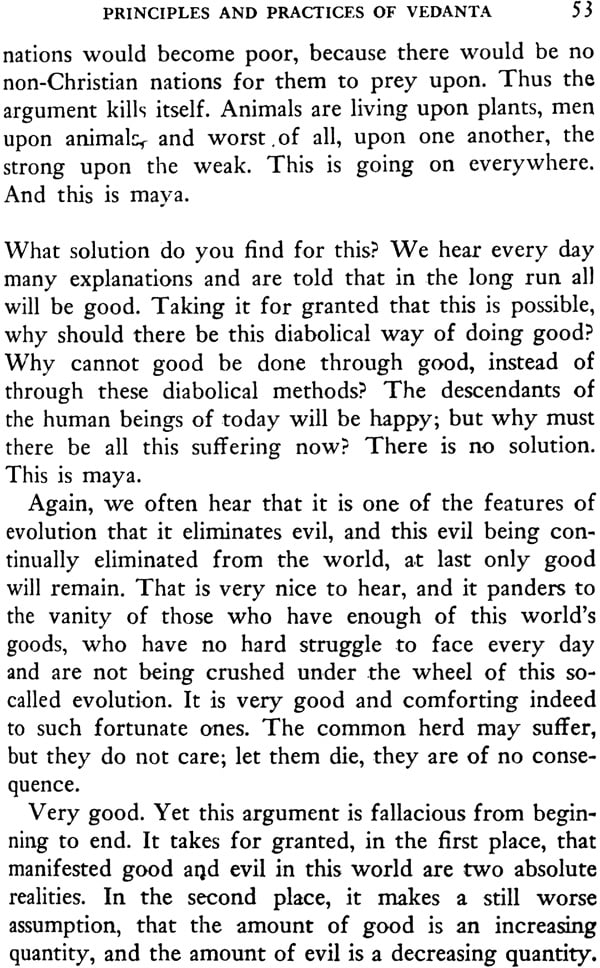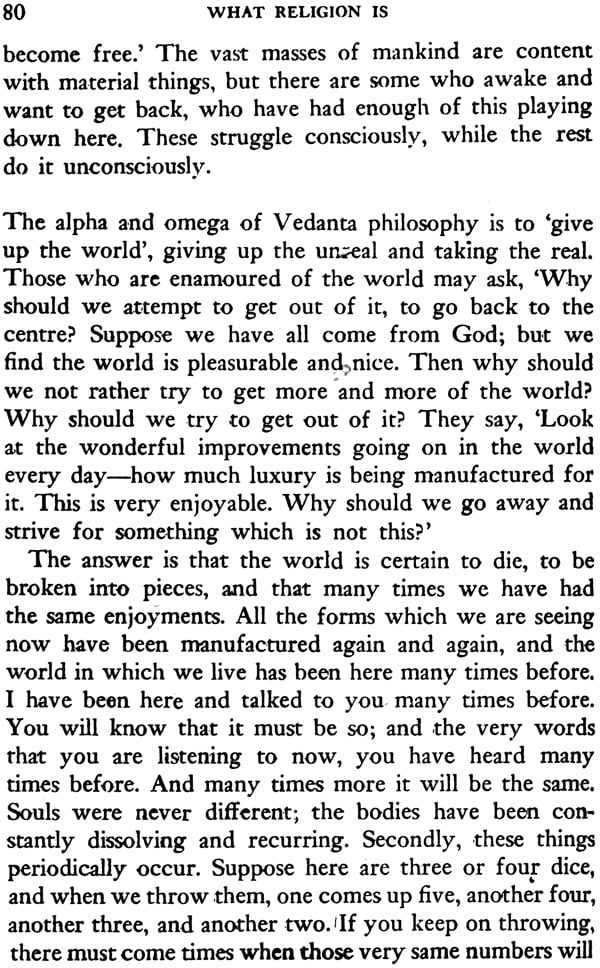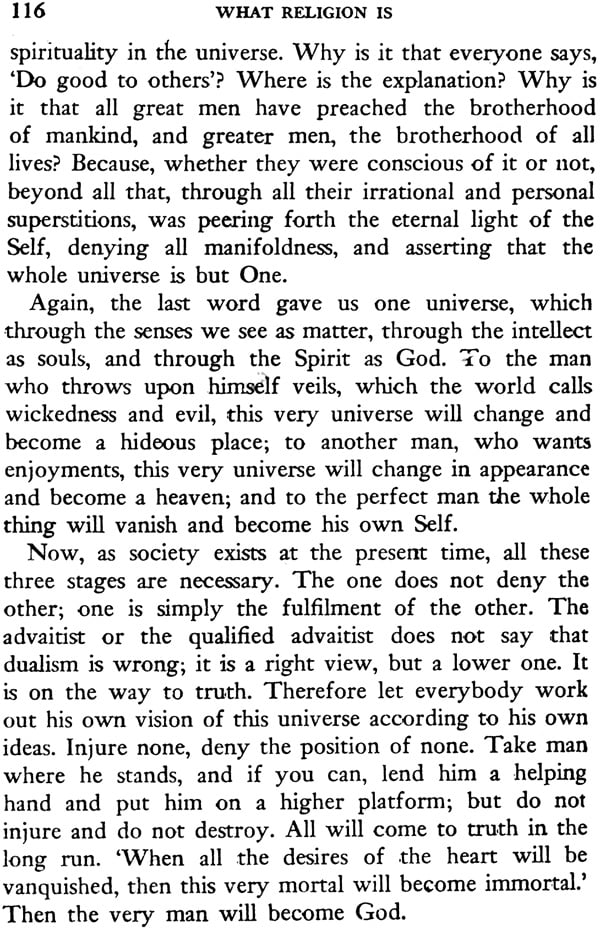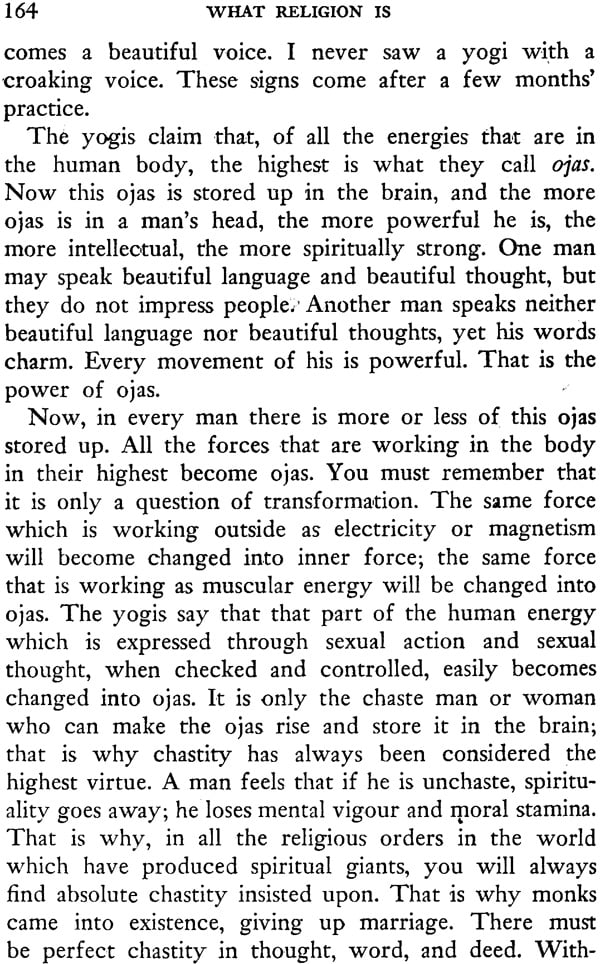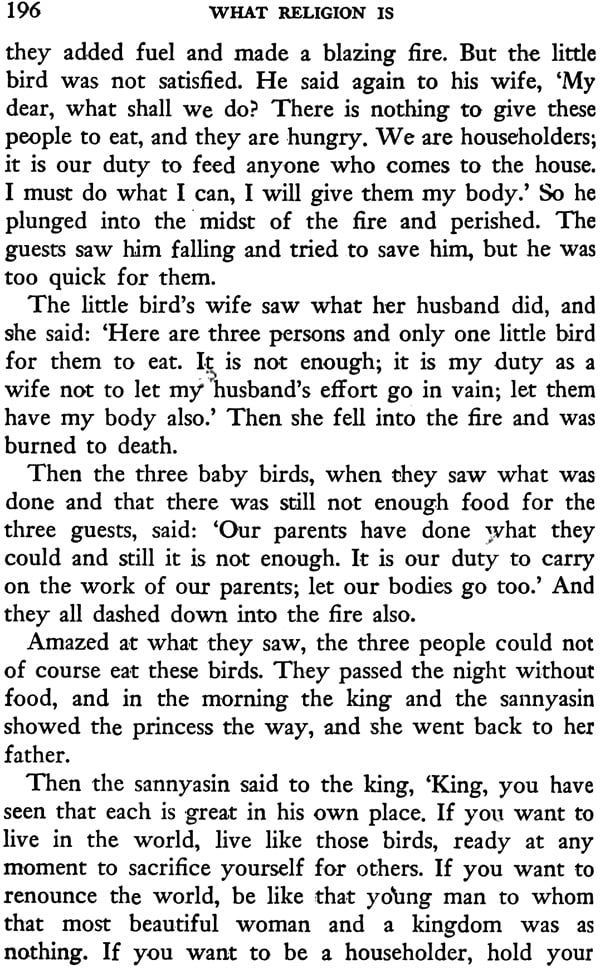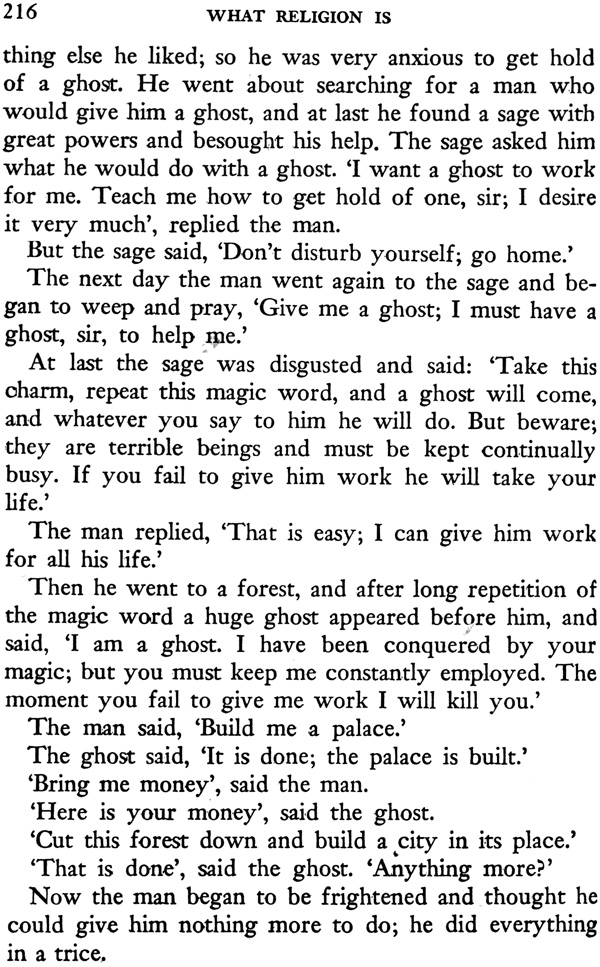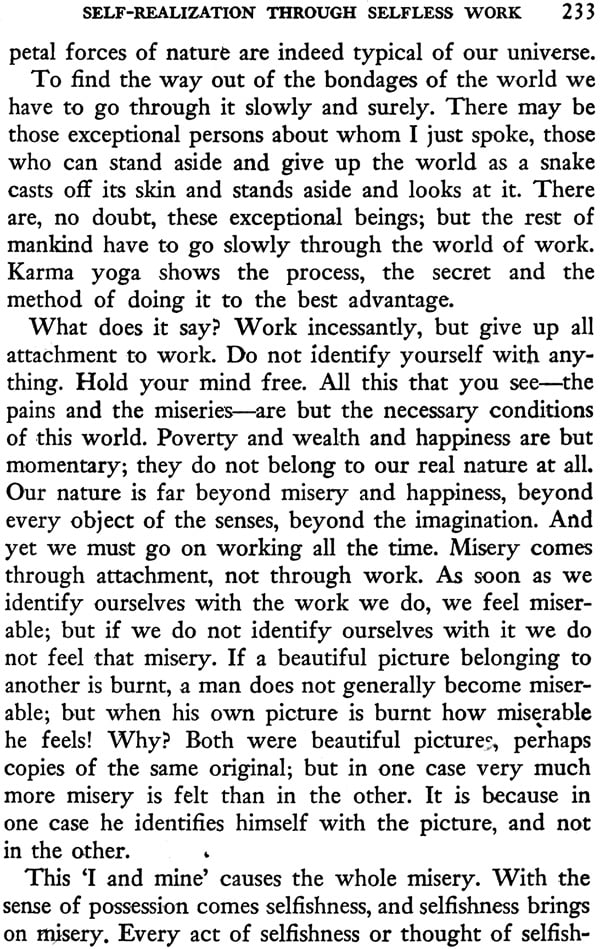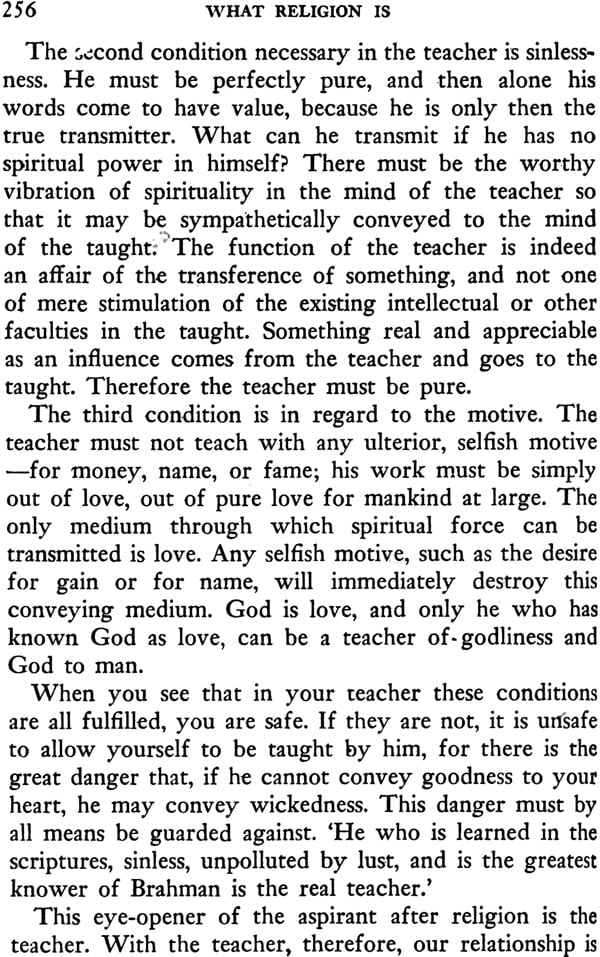
What Religions is (In The Words of Swami Vivekananda)
Book Specification
| Item Code: | NAE777 |
| Author: | Swami Vidyatmananda |
| Publisher: | ADVAITA ASHRAM KOLKATA |
| Language: | English |
| Edition: | 2011 |
| ISBN: | 9788185301457 |
| Pages: | 370 |
| Cover: | Paperback |
| Other Details | 7.0 inch x 5.0 inch |
| Weight | 290 gm |
Book Description
The wavy waters in the picture are symbolic of karma: and lotus, and the rising sun of jnana the encircling serpent is indicative of yoga and the awakened Kundalini Shakti while the swan in the picture stands for the Parmatman (Supreme self) therefore the idea of the picture is that by the union of karma, Jnana, Bhakti and yoga the vision of the Paramatman is obtained.
What Religion is in the Words of Swami Vivekananda was first produced by Phoenix House, Ltd., London, (copyright: Advaita Ashrama, Mayavati) in 1963 as a Birth Centenary tribute to the great teacher. It was designed by its compiler, John Yale, who is Swami Vidyatmananda of the Ramakrishna Order, to present Vivekananda’s thoughts and words on religion (spread over nearly 4200 pages of the eight volumes of his Complete Works) to the western reader in as systematic and concise a manner as possible. He has succeeded in collecting such essential thoughts in a volume not exceeding 100,000 words, which has served a generally- helpful purpose for readers both in the West and the East. This explains our publishing a moderately priced Indian edition of the book.
In this book we have all that is authentic and abiding, challenging and refreshing in Religion, and stated in a language that is perfectly understandable to modern mind. Hence we think that the book will be welcomed as a publication of absorbing interest everywhere in the world.
Although his public life covered only nine years, Swami Vivekananda’s literary output was very large. He gave lectures by the hundred, wrote articles and poems, and carried on a correspondence with people all over the world. By 1907, five years after the Swami’s death, the first collection of his works had been prepared for publication. This was printed on a hand press at a Himalayan monastery called the Advaita Ashrama, which Vivekananda himself had established a few years before. This initial compilation consisted of four volumes of about 250 pages each. At the tithe of their publication it was thought possible that enough additional lectures and writings might be collected to fill one further volume. What happened, however, was that material kept coming to light in such quantity that several more books were required; so that at the present time Vivekananda’s Complete Works comprise eight volumes of about 525 pages each, containing well over a million words. And even today previously unpublished lectures taken down by listeners two generations ago, letters from the Swami’s hand, and other literary relics associated with him continue to appear. As volumes of the Complete Works are reprinted, such additional selections must needs be added, further swelling their size.
Nevertheless, people in western nations wishing to acquaint themselves with the Swami’s thought would not have an easy time doing so. The eight-volume set is published in India, and although distributed in America and Europe, is too extensive to appeal to the average reader and too ‘special’ to he stocked in most book shops. A one-volume compilation of the Swami’s most important work—1,000 pages in length and containing 600,000 words—was brought out a few years ago by Swami Nikhilananda of the Ramakrishna-Vivekananda Center of New York. It is entitled The Yogas and Other Works. But again, the size and cost of this volume preclude popular circulation. Small booklets containing particular lectures or other self-contained writings by the Swami have been printed both in India and in western countries (some in several languages besides English); but unless taken together, these do not give a rounded presentation of his message.
What has been needed is a book of agreeable size and modest price, representative of the Swami’s teachings, published in the ‘Vest for western people. And if possible the material should be arranged so that a reader, devoid of previous knowledge of the subject, may follow the thread of Vivekananda’s thought in a systematic way. The present volume has been designed to meet these objectives.
It was felt that, ideally, the compact Vivekananda should be no more than 100,000 words long—in size roughly that of the average serious work of non-fiction. Obviously this book would need to be a compendium made of portions selected from the vast array of the Swami’s works, and these condensed. How to reduce to the desired dimension a quantity of material of more than ten times that size, and achieve a result both representative and balanced, required much study. Since the book was to be primarily for western audiences, however, the Swami’s many utterances about reforms in India could be omitted at the outset. it was also decided that for sack of space the poems and letters must be left out, although the latter especially are highly interesting.
What was done was to bring together those broadly applicable lectures and writings conceded to be the most important. These were arranged in an order which would assist the new reader to move into and through the Swami’s thought. An indication of the ideas covered and the order in which material dealing with them has been arranged is given in the following outline:
Today, as always, man seeks God—and often without knowing he is doing so. All human activity—good, bad, or indifferent—is actually the misapplied search for God.
The fact is that man in his true nature is already divine; but this divinity is covered. Life’s one purpose is the realization of divinity.
Realization of divinity is religion. At base, all religions teach this same truth although accretions often obscure it. Vedanta emphasizes the one ob3ective of realization but accepts diverse methods of reaching it.
Realization may be gained by the practice of the yoga of knowledge, or of control of mind, or of selfless work, or of love of God—or by a combination of yogas.
The great prophets of the world afford living examples of the realization of divinity. As models they inspire man, and as dispensers of grace they assist him towards realization.
From the works selected, overlapping, repetitions, and other material which could be sacrificed were cut out. Modern paragraphing, spelling, and punctuation were introduced. Except for a few explanations or definitions of Sanskrit terms and Editor’s additions inserted in square brackets, there is not a single Word in the body of the text or the introductions to chapters and sections which is not Vivekananda’s own. The Editor’s principal task consisted of: 1. arrangement; and 2. subtraction. The final text comes close to meeting the objective of being no more than 100,000 words in length.
Many reading this compact Vivekananda will want to acquaint themselves with the Swami’s life and words more fully. To this end, several recommendations can be made. The Yogas rid Other Works furnishes the full text of many of the selections included here in abbreviated form, together with a 200-page biography. The Complete Works, of course, are recommended. There are at least two full-length biographies of Vivekananda available, one the official Life, published by the Advaita Ashrama; and the other a life by the celebrated French writer Romain Rolland, which is available in English. A list of these works, as well as of source books on Vedanta generally, can be had by writing to the Vedanta Society of Southern California, 1946 Vedanta Place, Hollywood 28, California, and asking for the Vivekananda Reading List.
One Mornings early in September 1893, a lady named Mrs George W. Hale looked out through a window of her handsome home on Chicago’s Dearborn Avenue and saw, seated on the opposite side of the street, a young man of oriental appearance who was dressed in a turban and the ochre robe of a Hindu monk.
Mrs Hale was, fortunately, not a conventional woman. She did not call the police to tell the stranger to move on; she did not even ring for the servants to go and ask him what he wanted. She noticed that he was unshaven and that his clothes were crumpled and dirty, but she was aware, also, that there was a kind of royal air about him. There he sat, perfectly composed, meditative, serene. He did not look as if he had lost his way. (And, indeed, he was quite the opposite of lost, for he had just resigned himself to the will of God.) Mrs Hale suddenly made a most intelligent guess; coming out of her house and crossing the street, she asked him politely, ‘Sir, are you a delegate to the Parliament of Religions?’
She was answered with equal politeness, in fluent educated English. The stranger introduced himself as Swami Vivekananda and told her that he had indeed come to Chicago to attend the meetings of the Parliament, although he was not officially a delegate. As a matter of fact, he had first arrived in Chicago from India in the middle of July, only to find that the Parliament’s opening had been postponed till September. His money was running short and someone had advised him that he Would be able to live more cheaply in Boston, so he had taken the train there. On the train, he had met a lady who had invited him to stay at her home, which was called ‘Breezy Meadows’. Since then, he had given talks to various church and social groups, been asked a lot of silly questions about his country, been laughed at by children because of his funny clothes. The day before yesterday, Professor J. H. Wright, who taught Greek at Harvard University, had bought him a ticket back to Chicago, assuring him that he would be welcome at the Parliament, even though he had no invitation: ‘To ask you, Swami, for credentials is like asking the sun if it has permission to shine.’ The Professor had also given him the address of the committee which was in charge of the delegates to the Parliament, but this address Vivekananda somehow lost on his way to Chicago He tried to get information from passers-by on the street but, as ill luck would have it, the station was situated in the midst of a district where German was chiefly spoken, and the Swami could not make himself understood. Meanwhile, night was coming on. The Swami did not know how to obtain or use a city directory and so was at a loss how to find a suitable hotel. It seemed to him simpler to sleep in a big empty boxcar in the freight yards of the railroad. Next morning, hungry and rumpled, he woke, as he put it, ‘smelling fresh water’, and had begun to walk in a direction which brought him, sure enough, to the edge of Lake Michigan. But the wealthy homes of Lake Shore Drive proved inhospitable; he had knocked at the doors of several and had been rudely turned away. At length, after further wanderings, he had found himself here, and had decided to go no farther but to sit down and await whatever event God might send. And now, Vivekananda concluded, ‘What a romantic deliverance! How strange are the ways of the Lord!’
Mrs Hale must have laughed as she listened to this; for Vivekananda always related his adventures and misadventures with humour, and his own deep chuckles were most infectious. They went back together into the house, where the Swami was invited to wash and shave and eat breakfast. Mrs Hale then accompanied him to the headquarters of he committee, which arranged for his accommodation with the other oriental delegates to the Parliament.
The idea of holding a Parliament of Religions in Chicago had been conceived at least five years before this, in relation to the main project of the World’s Columbian Exposition, which was to be held to commemorate the four-hundredth anniversary of the discovery of America by Columbus. The Exposition was designed to demonstrate Western Man’s material progress, especially in science and technology. It was agreed, however, that all forms of progress must be represented, and there were congresses devoted to such varied themes as woman’s progress, the public press, medicine and surgery, temperance, commerce and finance, music, government and legal reform, economic science, and—strange as it may sound to us nowadays Sunday rest. And since, to quote the official language of the committee, ‘faith in a Divine Power has been, like the sun, a light-giving and fructifying potency in Man’s intellectual and moral development’, there had also to be a Parliament of Religions.
One may smile at all the pomposity, but it must be agreed that the calling of such a parliament was an historic act of liberalism. This was probably the first time in the history of the world that representatives of all the major religions had been brought together in one place, with freedom to express their beliefs. Paradoxically, the most genuinely liberal of the Parliament’s organizers were the agnostics; for they were interested solely in promoting inter-religious tolerance. The zealous Christians took a less impartial view, as was only to be expected. In the words of a Catholic priest: ‘It is not true that all religions are equally good; but neither is it true that all religions except one are no good at all. The Christianity of the future, more just than that of the past, will assign to each its place in that work of evangelical preparation which the elder doctors of the Church discern in heathenism itself, and which is not yet completed.’ In other words, heathenism has its uses as a preparation for Christianity.
But what really mattered was the acceptance of an invitation to preside at the Parliament by Cardinal Gibbons, leader of the American Catholics. This was all the more valuable because the Archbishop of Canterbury had refused to attend, objecting that the very meeting of such a parliament implied the equality of all religions. In addition to the Christians, the Buddhists, the Hindus, the Moslems, the Jews, the Confucians, the Shintoists, the Zoroastrians, and a number of smaller sects and groups were represented. Vivekananda could, of course, be counted as a recruit to the Hindu delegation; but in fact, as we shall see, he was standing for something larger than any one sect; the ancient Indian doctrine of the universality of spiritual truth.
When the Parliament opened, on the morning of 11th September Vivekananda immediately attracted notice as one of the most striking figures seated on the platform, with his splendid robe, yellow turban, and handsome bronze face. In his Photographs, one is struck by the largeness of his features they have something of the lion about them the broad strong nose, the full expressive lips, the great dark burning eyes. Eyewitnesses were also impressed by the majesty of his presence Though Powerfully built, Vivekananda was not above medium height, but he seems always to have created the effect of bigness. It was said of him that, despite his size, he moved with a natural masculine grace; ‘like a great cat’, as one lady expressed it. In America, he was frequently taken For an Indian prince or aristocrat, because of his quiet but assured air of command.
Others commented on his look of being inly-please’ he seemed able to draw upon inner reserves of strength all times, and there was a humorous, watchful gleam his eyes which suggested calm, amused detachment of spirit Everyone responded to the extraordinarily deep, bell-like beauty of his Voice; certain of its vibrations caused a mysterious psychic excitement among his hearers. And no doubt this had Something to do with the astonishing reaction of the audience to Vivekananda’s first speech.
| Preface to the First Indian Edition | III | |
| Editor’s Preface | V | |
| Introduction by Christopher Isherwood | XI | |
| Chapter One | The Ideal of a un | 1 |
| Chapter Two | Principles and practices of Vedanta | 43 |
| Chapter Three | Self Realization through knowledge | 103 |
| Chapter Four | Self Realization through control of mind | 141 |
| Chapter Five | Self Realization through selfless work | 183 |
| Chapter Six | Self Realization through loves of God | 245 |
| Chapter Seven | Great teachers of the world | 291 |
